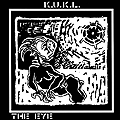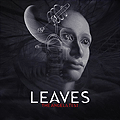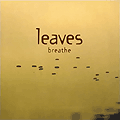

|
KUKL: The Eye (1984)
    
KUKL, while extremely puzzling to listeners of today’s radio waves, were discernibly integrated with the second (gothic) wave of post-punk, with their sound heading directly towards the Batcave and therefore largely reminiscent of goth's formative years. Still, while the band was and still is decidedly gothic, it was also much more prone to experimentation than what is perceived to be the case with other acts from the genre. After being first ushered together for a one-off performance, the band eventually came to release three albums in a more or less haphazard fashion. After three albums of vulgar experimentation, their creativity had finally reached a limit and everyone involved packed up their things and moved on to different musical landscapes. This album also peculiarly presents us Björk Gudmundsdottir sinking teeth into her first recorded material. While she can be found fairly low in the mix and will feel alien to fans of her solo work, her voice accentuates the dirgelike instrumentation and functions beautifully in the context of the music. Perry Farrell is another musician whose gothic history is more than a stain in the collective memory. Strangely enough, Björk’s first taste of real celebrity actually came when she danced and pranced around with a revealed pregnant tummy during a televised appearance for the band - much to the outrage of the general public of Iceland. The album begins with tribal-like and tin-canny percussion and drums with Björk’s moans barely audible in the distance. As the track progresses, you realize the drumming is extremely danceable! KUKL is perhaps best known of their embrace of the most trivial of instruments, and indeed, The Eye is littered with the strangest interludes of instruments such as pipes, whistles, varying degrees of percussion. At times, the album is sharp, angular and mathematic only to simultaneously be brashly unfocused, cacophonic and relentless. As noted before, the band’s focus on relentless experimentation (and thus lack of any type of commercial viability), The Eye is not for the faint of heart – it’s not hard to bypass the entire record as mere noise. Even with that said, there are many, many highlights on The Eye: The erratic percussive work on Assassin, the amazingly cacophonic yet soothing atmosphere of the song Moonbath, the tacky-catchy gothic sway of Dismembered (a hidden gem!) and the schizophrenic bassline of “The Spire”. However, all of this equally blends into a swirling mass and wall of noise that is hard to discern without repeated listen. Only for post-punk fanatics, but if you happen to be one, this is a real treat. Additionally of note is that as far as I know, The Eye is the only album in existence on which Björk's and Einar Örn Benediktsson's vocals actually blend together in a cohesive form of expression. While his yelps and raps on future Sugarcubes albums would effectively ruin the band's career, here both Björk and him play down the singing and rely on primal evocativeness and emotion.
KUKL: Holidays in Europe (The Naughty Nought) (1986)
    
On Holidays in Europe, all of the instruments - including Björk herself - have received far more space to operate individually in the mixing phase of the production, resulting in a much crisper sound that however does feel less distinct and less descriptive of the band's music overall. While the production is more multifaceted and now, with fancy experimentation and experiments in with reverb and echo that often results in an excellent spacious and crystal-clear drum sound so distinct of 80s post-punk, the overall situation feels far more refined, as the music has taken another turn to the wilderness. While the songs are far less catchy and driving, Björk plays an increasingly prominent role in the melodies of Holidays - a far more prominent role than was expected based on the first album. She sings now with class and style that would eventually be relished to its true potential in the Sugarcubes. She holds a note now and is very pleasurable to listen to even in all the brashness. On The Eye, KUKL was clearly a new band willing to experiment, but the band on Holidays in Europe is one that, at times, experiments for the sake of experimenting. Not a failed experiment, then, just more of a scientific approach.
Leaves: The Angela Test (2005)
    
While their sound indeed has been reinforced with many an element that would ring familiar to listeners of Coldplay-type pop (fragile piano playing, soaring strings and arpeggio-based guitarlines all drenched in reverb), on “The Angela Test”, the band carries these characteristics in a much more understated way, generating a style that - more often than not - resembles traditional indie rock and essentially leaves them bereft of all the positive character that originally propelled Coldplay into superstardom. As “The Angela Test” was preceded by a fairly successful first album entry into the music business, the band has been able to further improve the production values in a by-the-book manner on their sophomore effort. But what they’ve done with the money is the usual road to doom: Take the elements of your first album and extrapolate them to the max. What this results in is that since every classic rock production cliché can actually be found on the album, melodies are often buried underneath lush and diverse arrangements that only serve to swallow any intricacies of singer Gudjonsson’s vocal work. Thick and saturated, lazy drum tracks also overshadow the rest of the music without really propelling the band into any kind of momentum the songs might offer otherwise. Additionally, while Gudjonsson’s vocals and lyrics are professional, tactful and emotive to a record company executive extent, they don’t really operate in the context and scope of the music and are thus too bland to really carry the songs on its own weight. Particularly on the song “The Angela Test”, he manages to sound like a far less versatile – and soulless - Martin. Ouch. A common album rid with common problems!
Leaves: Breathe (2002)     
You’ll hear eBow and many minor-major key changes. You’ll have something what sounds dangerously like a mellotron. You’ll have a compulsory funky track for girls to dance to. You’ll find Gudjonsson sounding eerily like the vocalist from Keane. Frankly, while all this has been done before (and will further on be replicated again by the band on their badly titled next record, The Angela Test – and by thousands of other hands), most reviewers and I will still agree that cliché works better than expected on this particular record. While the whole record is too calculated, too refined, too formulaic for me, it still maintains a level of musical prowess and essentially is a well-crafted piece of craftsmanship. The real point with this record is that while I can keep my reviews as short as I desire, what of the poor guys and girls who actually have to find something to say of albums like Breathe? Aren’t most albums in fact much like this? Pretty, faceless, fine but oh-so-redundant? Marginally better than their second record. |






 Defining Iceland’s very own KUKL, the official school of punk for many of the country’s best-known musical heroes, is surprisingly straightforward if the band is seen in the light of the general musical backdrop of the 80s. The ease comes off as a surprise, as ease is seldom a word you can apply to other Icelandic bands: There is often a high level of enigma tied in with the sonic landscape of the island.
Defining Iceland’s very own KUKL, the official school of punk for many of the country’s best-known musical heroes, is surprisingly straightforward if the band is seen in the light of the general musical backdrop of the 80s. The ease comes off as a surprise, as ease is seldom a word you can apply to other Icelandic bands: There is often a high level of enigma tied in with the sonic landscape of the island. 
.gif) Holidays in Europe was KUKL's third and last album, preceded by a live record capturing a raw performance in France.
Holidays in Europe was KUKL's third and last album, preceded by a live record capturing a raw performance in France. As one of the most exportable (and therefore commercially viable) Icelandic bands of late, Leaves have predictably laid their hands on a very urban, refined sound. Indeed, most reviewers seem to concentrate on this very facet of the band – that is, by drawing convoluted comparisons between them and, say, blah blah -play blah blah -head. Due to this, portraying Leaves in a favourable light in a review of any kind (including mine) is problematic in itself, as even if the band had any personality or originality of their own, it has become largely difficult to analyze the band without comparing them back-to-back with the aforementioned list, and more importantly, making such comparisons will drastically restrict the discussion.
As one of the most exportable (and therefore commercially viable) Icelandic bands of late, Leaves have predictably laid their hands on a very urban, refined sound. Indeed, most reviewers seem to concentrate on this very facet of the band – that is, by drawing convoluted comparisons between them and, say, blah blah -play blah blah -head. Due to this, portraying Leaves in a favourable light in a review of any kind (including mine) is problematic in itself, as even if the band had any personality or originality of their own, it has become largely difficult to analyze the band without comparing them back-to-back with the aforementioned list, and more importantly, making such comparisons will drastically restrict the discussion.

